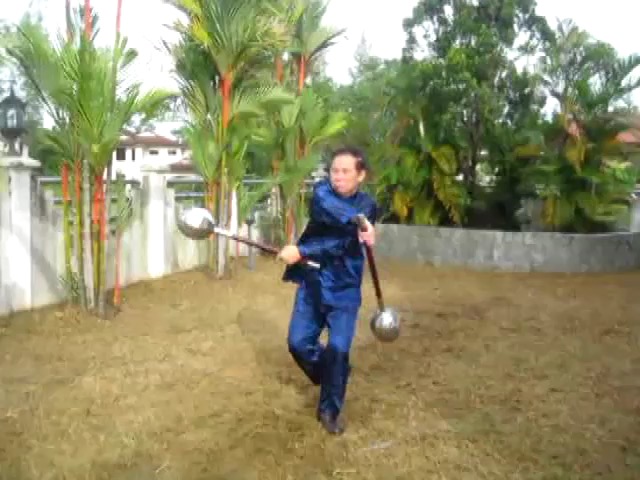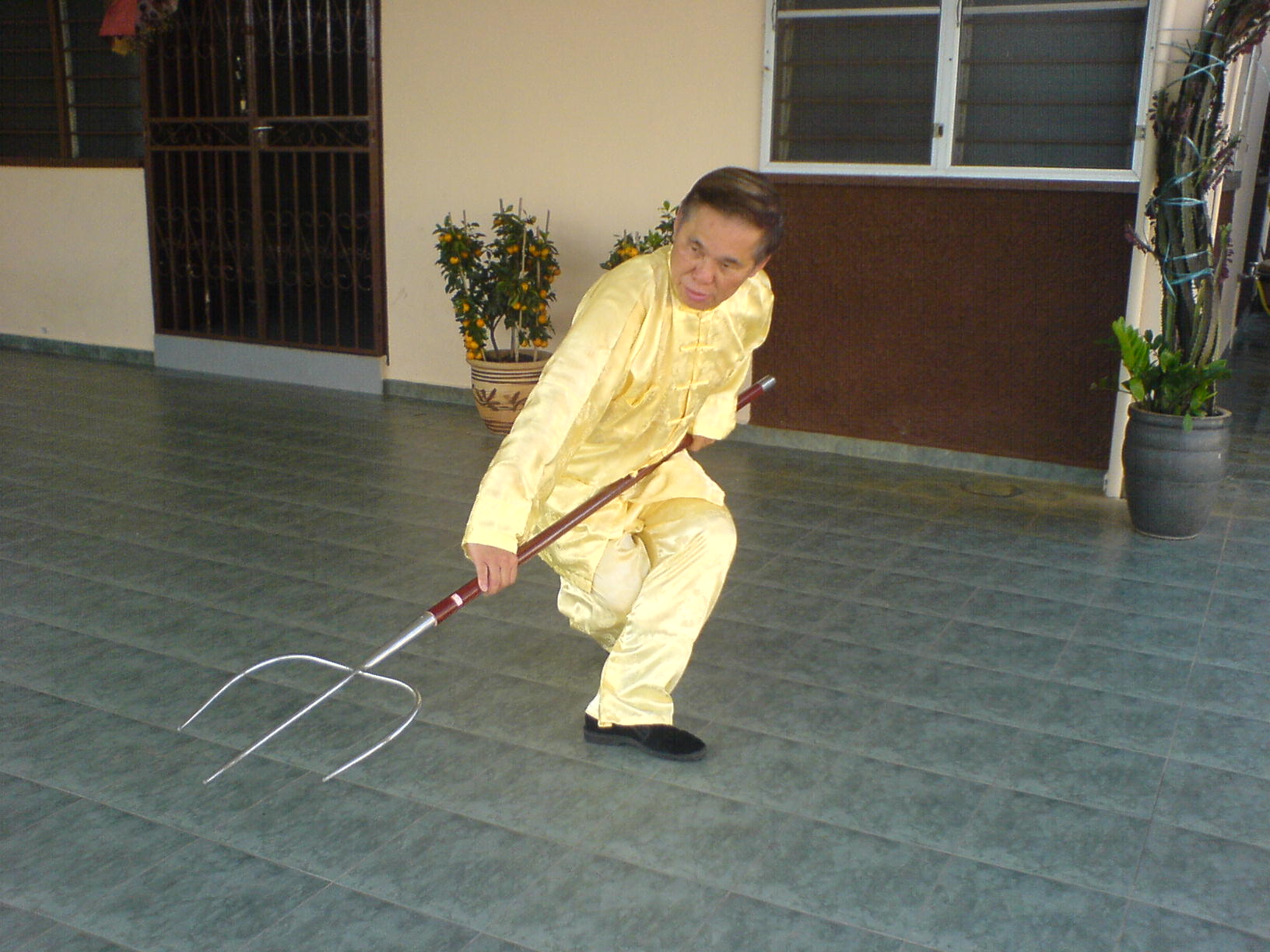THE WEIGHT OF WEAPONS

Round hammers are a pair of short heavy weapon
Question
I would like to ask about the weight of weapons in training and combat application. For instance, I've seen kungfu staff sets practiced with a heavy cast iron staff, and the original guan dao is reputedly a very heavy weapon.
Can you tell more about the weight of various weapons as they were used by past masters? What would be the benefits of training with various heavy weapons (intrinsically heavy or purposefully made so), and using a heavy weapon in combat?
Sifu Markus Kahila
Answer
There are two traditional ways to classify kungfu weapons – heavy and light weapons, and long and short weapons. Heavy weapons are usually, but not necessarily, long. Some heavy weapons are classified as short, while some long weapons are considered as light.
Examples of heavy weapons are Guan Dao, various types of Big Knife, Big Trident, Battle Axe, Square Spade, Crescent-Moon Spade, Long Staff, Round Hammers, Steel Whip, and Steel Rods. The former seven are long weapons, and the latter three short.
Examples of light weapons are Spear, Lance, Crescent-Moon Spear, Staff, Three-Sectional Staff, Sabre, Sword, Tiger-Hook, Clutch, and Dagger. The former three weapons are considered long, whereas the latter seven are short.
It is interesting that the Staff and the Three-Sectional Staff are considered short weapons though they are relatively long. Uncle Righteousness told me that the Staff was considered a short weapon in relation to the Long Staff. I guess the Three-Sectional Staff is also considered short because it issues from the Staff.
It is not clear whether the Soft Whip is considered a long or a short weapon. I would reckon that the Three-Sectional Soft Whip and the Five-Sectional Short Whip would be considered short, whereas the Seven-Sectional Soft Whip and the Nine-Sectional Soft Whip would be considered long.
It is also not clear whether the Soft Whip is considered a heavy or a light weapon. I would reckon it depends on the weight of a particular weapon itself, indicating that the Chinese were pragmatic, and not restricted by rigid classification, as some Westerners or some Western-educated Chinese seem to be. My three-sectional soft whip is heavy, whereas my nine-sectional soft whip, which is not much longer, is light.
As a side-note, in my early years of chi kung healing, some Western-educated Chinese asked me how I knew it was chi kung that cured some patients of cancer. Initially I was surprised at the question which suggested that they were restricted by classification. Later I actually told such people that it did not matter whether it was chi kung, or the food they ate, or the colour of their dress that cured the patients of cancer. The important thing was that they were cured.
Now I don’t have such silly questions. I attributed this to the high fees I charged for my chi kung healing. If they were ready to pay the high fees, they already knew they had a good chance to be cured by practicing chi kung.
It is the same with classifying weapons into heavy or light, long or short. What is important is that our weapon training gives us benefits in our daily life.
Hence the weight of a weapon must serve our purpose in our training, and effective in combat application. If it is too light or too heavy, it defeats the purpose of our training, and is ineffective in combat application.
The wushu weapons one purchases on the internet are too light. Not only they cannot chop through armour, an important function for many of the kungfu weapons in the past, it is likely that the weapons themselves would be damage rather than the opponents, when chopped on even scantily dressed persons. Even for wushu demonstration, they are not suitable. They fail to give an impression of power and ferocity they are meant to give or to train.
On the other hand, if the weapons are too heavy, they also defeat the purpose of training and combat application. Practitioners would be too pre-occupied with merely holding the heavy weapons to derive benefits for which the training is suppose to give. Burdened by the heavy weight of their weapons, they will be slow and clumsy in combat.
A heavy cast iron staff reminds us of the “yu yi jin gang bang” or literally “according to intention gold forceful cudgel” used by Monkey God. How heavy it was can be suggested by the legend that it was formerly used to support the Palace of the Dragon King in the Eastern Sea. Of course, to Monkey God, it was light and handy.
Amongst other benefits, a heavy cast iron staff would be useful for students to develop force. Ideally, there should be 10 different classes of staffs with weight ranging from fairly light, but students still need some effort to perform them, to very heavy where the same students initially could not even hold the staffs.
The ideal is for philosophical conceptualization. In practice it is sufficient to have three classes of staffs according to weight – light, medium and heavy. After a few years of training, if students find the staffs in the heavy category light and handy, they would have developed much force.
The same principle applies to other weapons. But staffs are most widely practiced, and are usually chosen for this purpose.
When I first learned the Fifth Brother Octagonal Staff, or Ng Long Pakua Kun in Chinese, I wanted to practice it daily (actually, nightly) to be skilful. I had one specially made of hard wood. I found it quite heavy.
Recently I used the same staff to be videoed for my autobiography, “The Way of the Master”. Despite a passage of more than 30 years, I was pleasantly surprised to find it light and handy.
The Guan Dao used by Lord Guan, a hero of the Three-Kingdom Period, was recorded to weigh 82 catties. A catty, which is a Chinese weight measurement, weighs more than one British pound, or more than half a kilogram. So the Guan Dao was really heavy.
However, the value of a catty varies according to different periods. So the Guan Dao may not be as heavy as a hundred pounds or 50 kilograms. Some experts have estimated the Guan Dao used by Lord Guan was about 35 to 40 kilograms of our time, which is still a very heavy weapon by any standard.
Except for the weight of the Guan Dao used by Lord Guan, as it was recorded in the famous Chinese classic, The Romance of the Three Kingdoms, I don’t know the weight of the weapons used by other past masters. I wonder whether the masters themselves knew the weight. As a master, he or she could use any weapon of any weight. If an available weapon were too heavy or too light, he or she would not use it.
However, I know of some past masters whose weapons were heavy. I also knew some masters whose weapons were light.
During the Three-Kingdom Period, Xu Chu and Dian Wei, who were Cao Cao’s generals and known for their enormous strength, used short, heavy weapons. Xu Chu used a pair of steel whips, and Dian Wei used a pair of short halberds, known in Chinese as “fang tian ji”. On many occasions Dian Wei, whose special duty was to protect Cao Cao, fought through ambushes to save Cao Cao.
Another warrior known for his enormous strength was Xue Ren Gui, a general of the Tang Dynasty. He used a heavy Big Trident.
However, both his son, Xue Ding Shan, and the son’s wife, Fan Li Hua, a Turkish princess, used light weapons, the spear. Fan Li Hua was so skilful with her spear that there was a style of spearsmanship known as Li Hua Spear.
Their son, Xue Gang, used a pair of Round Hammers. They were so heavy that they just smashed through any enemy.
The great Song Dynasty marshell, Yue Fei, used a heavy spear, though the spear was generally classified as a light weapon. Yue Fei’s spear was heavy because it was totally made of metal.
The Venerable Chee Seen, abbot of the secretive Shaolin Temple on Nine-Lotus Mountain, and his disciple, the Venerable Sam Tuck, abbot of the Western Zen Temple in Guangzhou, used a Zen mace, a long heavy weapon with thick metal stripes on top in the shape of a gourd. This was no surprise as many monks used Zen maces.
Pak Mei and Fung Tou Tuck, both Taoist priests, used a light weapon, a sword. Again, this was no surprise as all Taoist priests used swords.
Although Ng Mui was not Taoist, but a Buddhist nun, she also used a sword, although when she fought, which was not often, she did not need any weapon because she was so excellent in kungfu.
It was believed that before she renounced worldly life to become a nun, she was Lu Si Liang, a female kungfu knight. She used a sword to fight single-handedly though layers and layers of palace guards to assessinate Emperor Yong Zheng, who himself was excellent in kungfu, to avenge for the burning of the Shaolin Temple.
The main benefit of training with heavy weapons is to develop force. Good stances and speed are also trained. When a heavy weapon used in training is replaced with a similar lighter weapon in combat, the exponent can be very fast and powerful.
Using a heavy weapon in combat presents a lot of threat to opponents. The heavy weapon bulldozes into them. Those who try to block a heavy weapon would have their own weapons broken. Those who try to stand in the way would be pushed aside, unless they wanted to be smashed by the heavy weapon. This was a main reason how Dian Wei could protect Cao Cao on many occasions.
But there is no absolute in kungfu, or in life. While heavy weapons have their advantages, light weapons have their benefits too.

The weight of the big trident is employed to its advantage
This answer is taken from Special Weapon Course: 10 Questions to Grandmaster Wong of the Shaolin Wahnam Institute Discussion Forum.
LINKS
Courses and Classes
